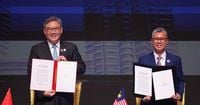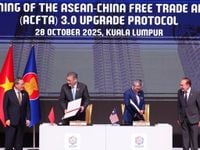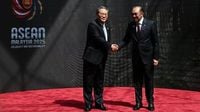On October 28, 2025, the bustling city of Kuala Lumpur, Malaysia, became the stage for a pivotal moment in global trade relations. China and the Association of Southeast Asian Nations (ASEAN) signed the expanded ASEAN-China Free Trade Area 3.0 agreement, a move that both sides hope will reshape economic dynamics across Asia and beyond. The signing, witnessed by Chinese Premier Li Qiang and Malaysian Prime Minister Anwar Ibrahim—this year’s ASEAN chair—underscored not just the growing economic ties between China and Southeast Asia, but also the shifting allegiances and strategies in a world grappling with protectionism and geopolitical rivalry.
The new pact, described by China’s State Council as the “3.0 version,” builds on the original agreement that came into force in 2010. It broadens collaboration to include infrastructure, digital and green transition, trade facilitation, and even people-to-people exchanges. The deal now covers a combined market of over 2 billion people, aiming to lower tariffs on goods, boost flows of services and investment, and—critically—make trade benefits more accessible to the region’s small and medium-sized enterprises, which form the backbone of ASEAN economies.
Trade between China and ASEAN has already been on a remarkable trajectory. According to The Associated Press, two-way trade has surged from $235.5 billion in 2010 to nearly $1 trillion in 2024. In the first nine months of 2025 alone, trade reached $785 billion—a 9.6 percent jump compared to the previous year, as reported by Al Jazeera. This growth is fueled by increasingly integrated supply chains and a steady flow of finished goods from China to Southeast Asian consumers. The two regions have, in fact, become each other’s largest trading partners, a status that reflects both economic necessity and strategic calculation.
Premier Li Qiang, speaking at the ASEAN-China summit, was quick to position Beijing as the champion of open markets and regional unity, especially in contrast to what he described as the rising tide of protectionism emanating from the United States under President Donald Trump. “Unilateralism and protectionism have seriously impacted the global economic and trade order, while external forces are increasing their interference in the region—many countries have been unreasonably subjected to high tariffs,” Li declared, as quoted by AP. He emphasized the importance of “mutual reliance” and urged ASEAN and China to “coordinate our actions” to safeguard their legitimate interests.
Li’s remarks were not without their critics. Philippine President Ferdinand Marcos Jr., whose country has long-standing territorial disputes with China in the South China Sea, welcomed the economic benefits of the upgraded pact but voiced a note of caution. “This cooperation cannot exist alongside coercion,” Marcos insisted, referencing the repeated maritime confrontations between Manila and Beijing. He called out what he described as “dangerous actions and harassment” by Chinese vessels and aircraft, and denounced Beijing’s plan to designate a disputed shoal as a “nature reserve”—calling it a thinly veiled attempt to assert sovereignty. “Actions like these cannot hide under the veneer of marine environmental protection because they have no legal basis or effect, blatantly disregard international law, and infringe on the Philippines’ sovereignty,” he said, according to AP.
Despite these tensions, Marcos indicated that the Philippines would continue to engage constructively with China, while also pushing to accelerate the conclusion of a Code of Conduct to govern behavior in the disputed waters. “Marcos aims to fast-track a Code of Conduct on the South China Sea during the Philippines’ ASEAN chairmanship in 2026,” noted AP. Other ASEAN members—Vietnam, Malaysia, and Brunei—share overlapping claims with China in the South China Sea, making the issue a persistent flashpoint even as economic ties deepen.
China, for its part, has accused the Philippines of “deliberate infringements and provocations at sea,” with Foreign Ministry spokesperson Guo Jiaku blaming Manila for recent escalations. Regional analysts, such as Bridget Welsh, argue that while the South China Sea dispute remains a thorny issue, it is often treated as a “separate track” from economic and security cooperation. “Non-U.S. countries are coming together to strengthen trade relationships for their prosperity even as a recoupling with the U.S. is ongoing,” Welsh observed, highlighting the pragmatic approach many ASEAN states are taking.
The upgraded trade pact comes at a time when China is seeking to shore up its relationships in Asia, as trade tensions with the U.S. and European Union continue to simmer. Zhiwu Chen, a finance professor at the University of Hong Kong, told Al Jazeera the deal is a “win-win outcome for both sides,” especially as China looks for reliable partners amid global uncertainty. “This is very important for China, as its trade tensions with the US and EU have been rising, and China needs ASEAN countries. At the same time, this is a time for ASEAN to take advantage of the window of opportunities precisely for the same reason,” Chen said.
The ASEAN summit also highlighted the bloc’s balancing act between the world’s two largest economies. Malaysian Prime Minister Anwar Ibrahim made it clear that ASEAN is determined to maintain friendly relations with both China and the United States. “The day before we were with President Donald Trump of the United States of America, and today we are back with China,” Anwar stated. “And that reflects ASEAN centrality. ... This is what we consider steady engagement that fosters trust that enables us to work through challenges together.”
President Trump, for his part, used his visit to the ASEAN summit to announce new economic initiatives with Cambodia, Malaysia, Thailand, and Vietnam—even as he maintained his latest round of tariffs. The deals finalized Trump’s “reciprocal tariff” rate on these countries, set earlier this year at 19 to 20 percent, according to Al Jazeera. Trump had also threatened to impose a 100 percent tariff on Chinese goods by November 1, after Beijing tightened export controls on rare earth minerals. However, ahead of a planned meeting between Trump and Chinese President Xi Jinping in South Korea later that week, there were signs that tensions might be easing. U.S. Secretary of the Treasury Scott Bessent announced that the two sides had reached a “framework agreement” on tariffs, which could help both countries “avoid” a damaging escalation.
Officials say the ASEAN-China Free Trade Area 3.0 is designed to make trade benefits more accessible, improve market entry for smaller players, streamline nontariff procedures, and lower regulatory barriers. The pact’s broadened scope—to include digital trade, green economy initiatives, and support for small businesses—reflects the changing nature of global commerce and the need for resilience in the face of economic headwinds.
As the summit drew to a close, Malaysian Prime Minister Anwar Ibrahim summed up the mood, noting that there had been consensus for engagement and that Li Qiang had agreed to accelerate negotiations on the Code of Conduct for the South China Sea. “All agreed that this region should not be an area of contestation of superpowers,” Anwar said, according to AP. In a world increasingly shaped by rivalry and uncertainty, ASEAN’s strategy of steady engagement and pragmatic partnership may prove to be its greatest strength.


